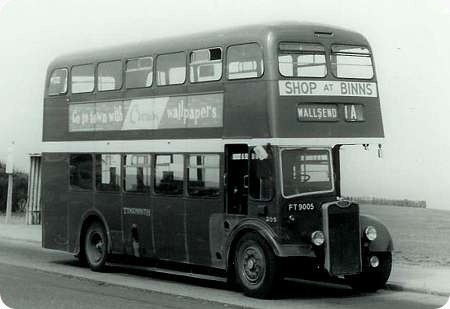Tynemouth and District – Guy Arab – FT 9005 – 205
Tynemouth and District
1955
Guy Arab IV
Weymann H33/28R
I’m not sure if these 1954, H33/28R Weymann Guy Arab IV’s were Aurora’s or Orion’s. Tynemouth and District had four; FT 7893/6 193/6; and when I started at Percy Main in 1967, they were the oldest D/D vehicles in service. This livery style was current when the vehicle was new, but was discontinued in 1956. All Northern General Transport vehicles underwent a complete overhaul and repaint at three yearly intervals, so the photo is pre 1957.
In 1955, they were followed by five Orion Arab IV’s; FT 9003/7 203/7; In addition to a greater seating capacity ‘H35/28R’ they had several other differences, no air ducts on the roof, the upper front windows had an opening vent above them, the rear side window on the upper deck had a vertically mounted opening vent, and they had a different rear light layout. As ever, NGT specified the Gardner 5LW engine for the GUY chassis and they seldom gave any trouble, but the body let them down. I don’t know if Weymann were working to NGT specifications, but too many corners had been cut to save weight, and they suffered badly as a result requiring constant maintenance. The interiors were positively Spartan, they were single skinned with exposed frames, and with nothing to stop them vibrating the side panels were constantly drumming. They became known as ‘the rattletraps’ and were never the most popular vehicles in the fleet, the last ones were withdrawn in 1968, and not many were sorry to see them go. Some of NGT’s went on to see service with other companies, so it speaks volumes for NGT that poorly built bodies lasted as long as they did. To be fair, by 1958, when the Orion bodied PD3/4’s came into service, lessons had been learned, they were well built and finished to a much higher standard and did not suffer from the shortcomings of their predecessors.
Photograph and Copy contributed by Ronnie Hoye
09/06/13 – 11:42
This is an Orion, Ronnie. The fact that it is a third rate, single skinned rattletrap confirms that. The Aurora was the interim design which retained the profile of the recently posted Sheffield Regent III with aluminium window pans of which Sheffield had hoards of PD2s and Regent IIIs. Sheffield and Manchester, and no doubt many others, had (nay demanded) improved later Orions built to Aurora standards and finish detail. To confuse the issue further, though, Weymann resurrected the Aurora name for the forward entrance version of the Orion – ie entrance just behind the engine. [Sheffield’s early Orions on Regent IIIs, Regent Vs and PD2s were atrocious just as these Guy’s bodies evidently were.]
David Oldfield
11/06/13 – 12:34
Even the Orion doesn’t look too bad on a real-radiator Arab IV! With that light body these 5LW Guys must have been pretty economical. Did someone replace the back axle at some time with one from an Arab III?
Ian Thompson
12/06/13 – 15:47
Well spotted, Ian, I never noticed that. From the photos I have of the rest of T&D’s Arab IV’s this must be a one off in that respect as the remainder have much larger rear hubs. Many of the half cabs in the fleet didn’t have a full interior window behind the driver, they had a small sliding one at the top that enabled the conductor to talk to the driver, the larger space at the bottom where the window would have been was a case for adverts, this one would seem to be the latter
Ronnie Hoye
12/06/13 – 21:08
That’s pretty mean of them—blanking out the window behind the cab! Normal passengers would have been deprived of the view forward and abnormal children like me (any other volunteers?) couldn’t have stood on tiptoe in fascination watching the driver.
Ian Thompson
17/06/13 – 06:41
You were not alone, Ian. In Manchester drivers could draw a blind to cover the window behind them. About half of them did, which was very disappointing. But when they didn’t, I learned exactly half of how to drive a bus – the right half. I had no idea what happened on the left.
Peter Williamson
17/06/13 – 10:19
I too learnt a lot about how to drive from sitting behind the driver: including what to do if someone pulls out in front of you: no, it didn’t include braking. The cab blind was to stop night-time lighting reflection: it often had a little square hole in it: they have cctv today. Fortunately few drivers used it in the day: it prevented non-verbal communication with the conductor, be that male or, yes, female.
Joe
Quick links to the - Comments Page - Contact Page - Home Page
Comments - Please note: The comments facility is not currently available. Please see the home page for updates.
Please Note if you want to send a photograph with your comment please use the Contact Page by clicking here or send as an attachment via email.

